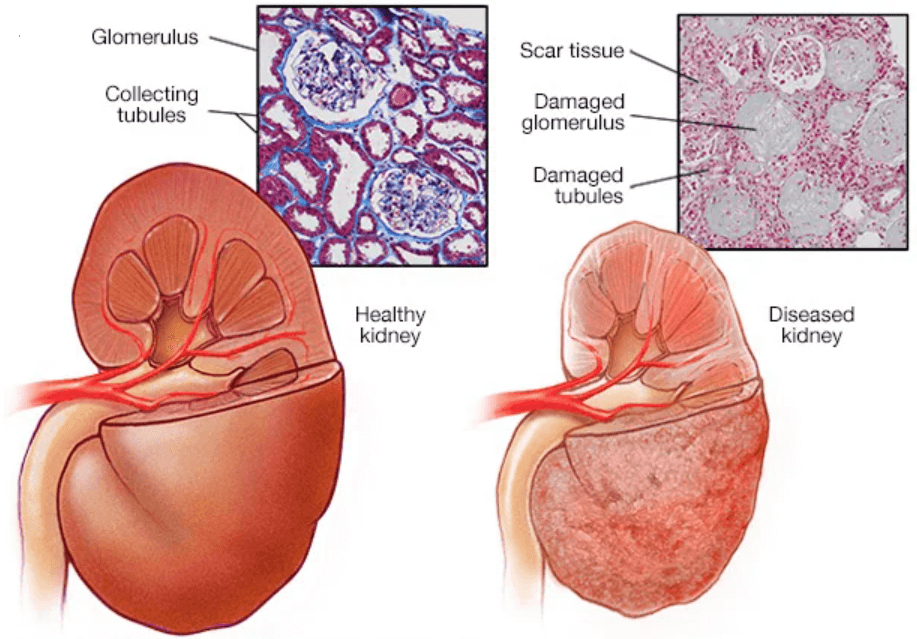Diabetic Nephropathy and Kidney Health
Diabetic nephropathy is a slowly progressing condition that can be hard to detect. You may not notice any symptoms until your condition has progressed into later stages.
Diabetic nephropathy happens when you develop kidney disease as a result of complications from diabetes.
You may never experience any severe symptoms with diabetic nephropathy. But some other conditions, like high blood pressure, can increase your chance of complications.
Read on to learn more about the early signs and symptoms, some common causes of diabetic nephropathy, and what diagnosis and treatment options are available.
Early diabetic nephropathy symptoms and signs
As with most kidney diseases, diabetic nephropathy has five stages. Doctors determine each stage using a couple of factors:
- glomerular filtration rate (GFR), which is a measurement of how well your kidneys are filtering out toxins and other waste
- damage and functionality, which refers to how much kidney damage you have and how the condition is affecting your kidney function
In the first stage, you probably won’t notice any symptoms at all. Your GFR is usually above 90, and your kidneys are probably still functioning well enough to prevent you from experiencing symptoms.
| Stage | GFR | Damage and functionality |
|---|---|---|
| 1 | 90 and higher | This is the mildest stage, meaning your kidneys have some damage but are still functioning at a typical level. |
| 2 | 89–60 | Your kidneys are damaged and have some loss of functionality. |
| 3 | 59–30 | Your kidney has lost up to half of its functionality. This may also lead to problems with your bones. |
| 4 | 29–15 | This means severe kidney damage. |
| 5 | lower than 15 | This is kidney failure, so you’ll need dialysis or a kidney transplant. |
First symptoms of diabetic nephropathy
You’ll likely start to notice the earliest symptoms at stage 2, your GFR begins to dip below 89. But even at this stage, it’s still possible that your symptoms will be very mild.
Some of the first symptoms of diabetic nephropathy include:
- occasional fatigue that’s not dependent on your activity level
- loss of appetite for no clear reason
- consistent headaches
- dry or itchy skin that’s not connected to weather or humidity levels
- nausea
- vomiting with no apparent cause
- mild swelling in your arms and legs
First signs of diabetic nephropathy
You should see a medical professional if you’re starting to experience symptoms of diabetic nephropathy, even if they’re mild.
A doctor can perform a physical exam and order some diagnostic tests to look for early signs of diabetic nephropathy. This can help detect early stage diabetic nephropathy even if you don’t have noticeable symptoms.
Some early signs of diabetic nephropathy include:
- creatinine levels of 30–300 milligrams per gram (g)
- urine protein levels above 3.5 g per day
- low levels of albumin (hypoalbuminemia)
Other symptoms of diabetic nephropathy
Other symptoms of diabetic nephropathy include:
- constant fatigue
- a general feeling that you’re unwell
- increasing high blood pressure over time
- swelling in your hands, feet, or eyes
- shortness of breath
- confusion
- difficulty focusing
- worsening nausea and vomiting
- foamy urine
Other signs of diabetic nephropathy
A doctor may refer you to a specialist to examine you for other signs, including:
- peripheral vascular disease
- high blood pressure
- coronary artery disease
- eye damage from diabetes (diabetic retinopathy)
Diabetic nephropathy causes
High blood pressure and high blood sugar related to diabetes are the two main causes of diabetic nephropathy.
Other factors that can increase your likelihood of diabetic nephropathy include:
- African American, Hispanic, or American Indian ancestry
- a family history of kidney disease
- type 1 diabetes that develops before you’re 20 years old
- smoking
- obesity
- eye disease or nerve damage from diabetes
Diabetic nephropathy diagnosis
Some tests doctors use to diagnose diabetic nephropathy include:
- microalbuminuria urine test to check your albumin levels
- blood urea nitrogen blood test to check for high levels of urea nitrogen in your blood
- serum creatinine blood test to check creatinine levels in your blood
- renal biopsy to check your kidney tissues for signs of disease
Diabetic nephropathy treatment
Depending on your symptoms and stage, treatment options for diabetic nephropathy include:
- medications to control your diabetes symptoms and prevent complications
- diet and lifestyle changes, such as reducing your sodium intake or increasing your activity level to control your blood pressure
- dialysis to help your kidneys function more effectively
- kidney transplant to replace one or both kidneys
Credit: Kelly Wood, Tim Jewell, healthline.com

